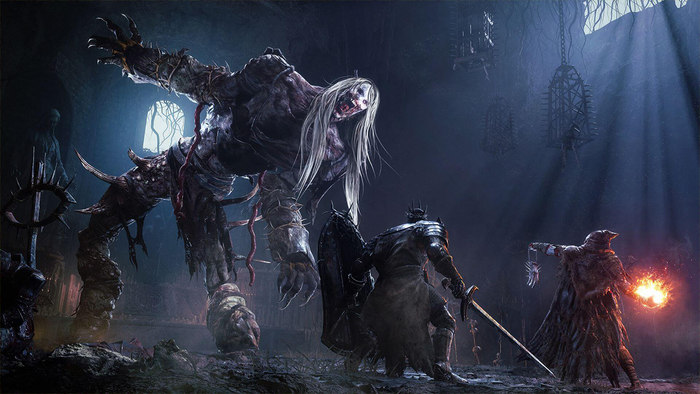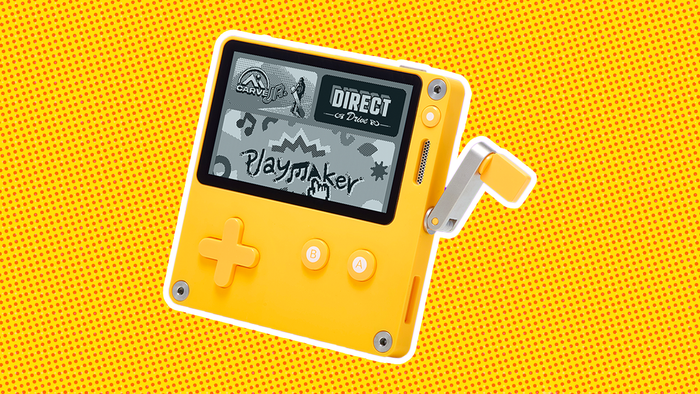"It's the only time I've ever felt scared looking at a puzzle," says Bennett Foddy of QWOP and Super Pole Riders. "And it's nothing more than an artful arrangement of sausages."
April 22, 2016

Stephen "Increpare" Lavelle’s new game Stephen’s Sausage Roll is surreal and hilarious. It's also one of the most difficult and brain-scratching puzzle games to come out in recent years.
The game features a fairly simple mechanic somewhat reminiscent of Sokoban. Each puzzle revolves around the goal of perfectly cooking sausages by rolling them onto grill tiles until they are pleasingly browned on both sides. The difficulty comes from maneuvering the sausages around without knocking them off of a little island, or allowing the sausages to burn by letting one side touch the grill more than once.
A quick Twitter search would tell you that Stephen’s Sausage Roll is receiving praise from all corners of the game development community, as well as plenty of consumers.
Why exactly is Lavelle’s simple (and strange) puzzle game causing such animated discussion? We reached out to several devs to find out.

WHY DO DEVS LOVE TO ROLL SAUSAGES SO MUCH?
Terry Cavanaugh, of Super Hexagon fame, used to be flatmates with Lavelle, and watched the game change over the course of its development. “I got to see the incredible thought and attention to detail that went into it first hand as he painstakingly iterated over every level and somehow brought this enormous thing together as a cohesive whole," Cavanaugh wrote on his blog.
"People are calling it the Dark Souls of puzzle games," Cavanaugh adds, "which is fitting for lots of reasons – it’s bloody hard, for one – but mostly because, like the original Dark Souls, every part of this thing is deliberate and meticulously designed. It’s a masterpiece.”
Bennett Foddy, creator of QWOP, GIRP and Super Pole Riders, also knows Lavelle, and admits he's the person who suggested the title of the game. He's unreserved in his praise for it. “One of the best things about Stephen’s Sausage Roll is that in almost every level, you reach a point where you become certain that the puzzle is impossible,” Foddy explains
Foddy says that Lavelle's game drives you to a point of despair. You believe that you've gone through all the possibilities in your head and you conclude that you’ve already tried every combination of moves, and there is just no way that you can get the sausages cooked. "But inevitably, you push yourself to the point where you realize that there is some deep fact about the system that you previously knew but didn’t fully understand," says Foddy. "When you use that new knowledge to solve the puzzle it feels like your brain leveled up."

For Foddy, every level in the game provides that kind of eureka moment. "That's quite staggering when you consider that the rules are never arbitrary, and they never change — you’re never given an extra button to press, or an extra type of sausage, anything like that," he says. "The depth that the game manages to find in a single sort-of-physical system is absolutely insane."
“This is the first game I’ve ever played where I’d call solving each puzzle a ‘victory,'" Foddy adds. "With each victory, you move on to the next battle with a mixture of triumph and trepidation, knowing that the next challenge will push you even further past your limits. It’s the only time I’ve ever felt scared looking at a puzzle—which is all the more wonderful when the puzzle was nothing more than an artful arrangement of sausages.”
Alan Hazelden, the creator of Sokobond, which features a similar core idea to Stephen’s Sausage Roll, is also impressed by how much Lavelle was able to do within the constraints of his design. “The most amazing thing about this game is how it constantly expands the scope of what's possible while never adding new mechanics, forcing you to discover behavior that's always been a logical consequence of the system," he says. "It's a masterclass of design that respects your time and your intelligence in a way that few games are bold enough to do.”
Sarah Northway, of Northway Games, concurs. "Every level feels perfectly crafted, designed to lead you to epiphany after epiphany with no unnecessary labor in between," she says.

Michael Brough, of 868-Hack and Corrypt, has this to say: “The state space is so huge compared to your classic Sokoban puzzle; Stephen and the sausages each take up a 2x1 space, orientation matters, sausages have two sides. It's sort of like every sausage adds the complexity of maybe four Sokoban blocks. But all that complexity is chunked in an intuitive way -- it's just a sausage. So you get these really tiny levels, you might be pushing just one sausage around a 3x3 room but there's still enough possibilities to baffle you.”
Lucas Pope of Papers, Please and the upcoming Curse of the Obra Dinn, agrees. “The puzzles start out hard and get harder, but there's something fantastically sublime and implicit about the design. Even though I consciously feel absolutely confused and stuck, my subconscious has all along been secretly learning about the fork's control and sausage movements. By just continuing to play I'll solve puzzles that looked overwhelmingly impossible at first.”
One thing that comes up again and again is the incredible depth that Lavelle has found with such a simple mechanic. To Ricky Haggett of Honeyslug, creators of Hohokum and Frobisher Says, this is a breath of fresh air when so much of the conversation is about new technology.
“The thing that really comes across from replaying the first bunch of levels, is how much depth there is simply in the way the character moves around and interacts with the sausages!" he says. "It's really exciting to think that people have been making thousands of video games for decades now, and yet there is still all this incredible treasure to be discovered just below our feet! I felt the same about Devil Daggers: how incredibly cool it is that it's 2016, and yet still possible to make a game this mechanically simple which does something completely new. It's one of the things that makes video games such an exciting medium -- you hear a lot about the tech (like VR right now), but I find the riches of a game like Stephen’s Sausage Roll just as exciting!”

BOLD PRICING AND MINIMAL MARKETING
Almost as notable as the game itself is the way that Lavelle is choosing to market it, which is to rely almost entirely on word of mouth. He’s charging $30 for Stephen’s Sausage Roll, and he's not employing a hard sell. The Steam page is as sparse as it could possibly be, with the game’s description, which is usually paragraphs long on any other release, being merely "A simple 3D puzzle game." Even the trailer is little more than a few aerial shots of some of the levels.
The developers we talked to were on board with Lavelle’s decision.
“It’s so easy to spoil the surprises in a game like this, and that makes marketing it a bit of a challenge,” Bennett Foddy suggests. “But I believe that people are basically smart, and when something as shockingly ambitious as this comes along, it usually bubbles up to the top.”
Many suggested that the large quantities of good will that Lavelle has built in the indie game scene also helped allow him to let the game speak for itself.
“He's absolutely a pillar of the community,” says Brough. "His work with freeindiegam.es made a difference to a lot of us, taking the time to dig up and share the interesting games that were being made but that nobody was talking about. So like the most prolific and influential game maker releases a huge title he's worked on for four years, who isn't going to be paying attention? Come on.”
George Buckenham, currently working on Fabulous Beasts, also cites Lavelle’s constant and consistently good output as more than enough in the way of marketing. “It's Stephen. He's someone who will work for weeks on a freeware release and then announce it only with a tweet saying, 'new game : [amazing game goes here].' I think the best lesson to learn from his release strategy is how much fun he seems to be having with it.”
"It's one of the best, and also one of the most difficult puzzle games I've ever played," says Northway. "I think this is why word of mouth marketing is a good fit, because fans of this sort of challenge will be eager to share it."
You May Also Like





